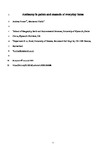Antimony in paints and enamels of everyday items
| dc.contributor.author | Turner, A | |
| dc.contributor.author | Filella, M | |
| dc.date.accessioned | 2020-02-28T11:20:11Z | |
| dc.date.issued | 2020-04-15 | |
| dc.identifier.issn | 0048-9697 | |
| dc.identifier.issn | 1879-1026 | |
| dc.identifier.other | 136588 | |
| dc.identifier.uri | http://hdl.handle.net/10026.1/15417 | |
| dc.description.abstract |
Concentrations of antimony have been determined for paints and enamels that are available to the consumer or accessible to the public by x-ray fluorescence spectrometry. The metalloid was only present in consumer paints of a speciality (e.g. artistic) nature, but was common in old household paints as an anti-chalking agent and in brightly-coloured contemporary exterior paints (on roads, street furniture and playground equipment, for example) as a colour fastener with concentrations ranging from a few hundred to about 25,000 μg g-1. Antimony was also found in contemporary container glass and ceramic products as an additive or opacifier and as a colour fastener in enamels at concentrations up to a few thousand μg g-1. Overall, the yellow pigment, lead antimonate, was only evident in two ceramic products analysed, with Sb concentrations exceeding 62,800 μg g-1. Available data in the literature suggests that, while Sb concentrations up to 30 μg g-1 are bioaccessible in exterior paints and that concentrations of up to 20 mg L-1 are migratable in some ceramicware, no relevant regulations are currently in place. Given our lack of understanding of the health impacts of Sb, more studies on its toxicity and mobility from commonly encountered products are called for. | |
| dc.format.extent | 136588-136588 | |
| dc.format.medium | Print-Electronic | |
| dc.language | en | |
| dc.language.iso | en | |
| dc.publisher | Elsevier | |
| dc.subject | Antimony | |
| dc.subject | Paints | |
| dc.subject | Enamels | |
| dc.subject | Ceramics | |
| dc.subject | Glass | |
| dc.subject | XRF | |
| dc.title | Antimony in paints and enamels of everyday items | |
| dc.type | journal-article | |
| dc.type | Article | |
| plymouth.author-url | https://www.ncbi.nlm.nih.gov/pubmed/31958724 | |
| plymouth.volume | 713 | |
| plymouth.publication-status | Published | |
| plymouth.journal | Science of the Total Environment | |
| dc.identifier.doi | 10.1016/j.scitotenv.2020.136588 | |
| plymouth.organisational-group | /Plymouth | |
| plymouth.organisational-group | /Plymouth/Faculty of Science and Engineering | |
| plymouth.organisational-group | /Plymouth/Faculty of Science and Engineering/School of Engineering, Computing and Mathematics | |
| plymouth.organisational-group | /Plymouth/Faculty of Science and Engineering/School of Geography, Earth and Environmental Sciences | |
| plymouth.organisational-group | /Plymouth/REF 2021 Researchers by UoA | |
| plymouth.organisational-group | /Plymouth/REF 2021 Researchers by UoA/UoA07 Earth Systems and Environmental Sciences | |
| plymouth.organisational-group | /Plymouth/REF 2021 Researchers by UoA/UoA12 Engineering | |
| plymouth.organisational-group | /Plymouth/Research Groups | |
| plymouth.organisational-group | /Plymouth/Research Groups/BEACh | |
| plymouth.organisational-group | /Plymouth/Research Groups/Marine Institute | |
| plymouth.organisational-group | /Plymouth/Users by role | |
| plymouth.organisational-group | /Plymouth/Users by role/Academics | |
| dc.publisher.place | Netherlands | |
| dcterms.dateAccepted | 2020-01-06 | |
| dc.rights.embargodate | 2021-1-10 | |
| dc.identifier.eissn | 1879-1026 | |
| dc.rights.embargoperiod | Not known | |
| rioxxterms.versionofrecord | 10.1016/j.scitotenv.2020.136588 | |
| rioxxterms.licenseref.uri | http://www.rioxx.net/licenses/all-rights-reserved | |
| rioxxterms.licenseref.startdate | 2020-04-15 | |
| rioxxterms.type | Journal Article/Review |


